“Camp of the Gros Ventres of the prairies on the upper Missouri” c. 1840
Karl Bodmer (1809–1893)
Courtesy Rare Book Division, The New York Public Library.[1]“Lager der Gros Ventres des prairies am obern Missouri. Camp des Gros Ventres des prairies sur le Missouri. Camp of the Gros Ventres of the prairies on the upper Missouri.” New York … Continue reading
When the expedition passed the above place in the Upper Missouri River Breaks, they only saw signs of the Atsina People. Imagine how the Expedition may have been different had the site been occupied when they arrived on 30 May 1805.
In 1772, Hudson’s Bay employee Mathew Cocking met the Atsina at the forks of the Saskatchewan and called them the Waterfall Indians. The captains, in their “Estimate of the Eastern Indians,” identify these people as the “Falls Indians.” Today, they are known as the Atsina or Gros Ventre, but their names in the historical literature—Big Bellies, Gros Ventre and Minnetares—cause confusion even to this day. These names are given to two very different tribes, the Hidatsa of the northern plains, and the Atsina of north central Montana and Saskatchewan. The terms “Gros Ventres of the Prairie” (Atsina) and “Gros Ventres of the Missouri” was adopted in the 19th century to avoid confusion.
On 28 May 1805 Clark calls them “Minetaries of Fort de Prarie.” Patrick Gass begins his 28 July 1806 re-telling of Lewis’s fight on the Two Medicine by calling the young thieves “Prairie Grossventres.” In fact, the expedition never did meet any Atsina People. The boys were Blackfeet, close allies with the Atsina.[2]For the dangers of this portion of the expedition, see The Marias River Risk. Perhaps the lack of Atsina presence on the Lewis and Clark route was due to smallpox epidemics in 1780 and 1801.[3]Loretta Fowler and Regina Flannery, Handbook of North American Indians: Plains Vol. 15, Raymond J. DeMallie, Ed. (Washington, D.C.: Smithsonian Institute, 1978), 677–67.
The presence of the Atsina did, however, have a profound effect on the way several tribes interacted with the expedition. The British traded arms with the Blackfeet, Atsinas, and Assiniboines giving those people an advantage over their southern neighbors, the Nez Perce, Salish, and Lemhi Shoshone had difficulty obtaining Trade Guns. Neither could the disadvantaged tribes obtain arms from the Spanish who refused on policy. When asked for weapons, the captains could only give the Nez Perce, Salish, and Lemhi Shohone little more than promises and assurances.
Much of the poverty the captains witnessed while among the Lemhi Shoshone were due to recent raids by the Atsina. When Lewis met Cameahwait on 13 August 1805, they smoked a pipe in the only leather lodge they had. The rest had been stolen in an Atsina raid:
these people had been attacked by the Minetares of Fort de prarie this spring and about 20 of them killed and taken prisoners. on this occasion they lost a great part of their horses and all their lodges except that which they had erected for our accomodation; they were now living in lodges of a conic figure made of willow brush
—Meriwether Lewis
On the return trip, Lewis had to cross the Continental Divide without Nez Perce guides. They would not accompany him on the Road to the Buffalo that crosses present-day Lewis and Clark Pass. As Lewis described it, the “Nez Perce refused to continue for fear of the ‘Pahkees.’ Pahkee is likely from the Shoshone /pakihï’ï/ meaning rawhide armor, a reference to the tribe’s enemies: the Blackfeet, Atsina, Arapahoe, and Assiniboine.[4]Moulton, Journals, 8:90n9; William Bright, A Glossary of Native American Toponyms and Ethnonyms from the Lewis and Clark Journals, University of Colorado, accessed on 28 April 2020, … Continue reading
Today, the Atsina identify as Gros Ventre, but are also known as Aaniiih, A’aninin, Haaninin, and White Clay. Many are members of the Fort Belknap Indian Community, a federally recognized tribe from Montana that also includes Assiniboine People.[5]“Gros Ventre,” Wikipedia accessed on 24 November 2020, https://en.wikipedia.org/wiki/Gros_Ventre.
Selected Encounters
July 4, 1806
Dangerous roads
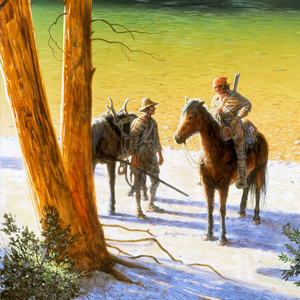

Lewis travels east on “Cokahlahishkit”—the Road to the Buffalo—along the Blackfoot River. Clark travels south up the Bitterroot River and celebrates the Fourth of July with a “Sumptious Dinner”.
August 3, 1806
Clark reaches the Missouri
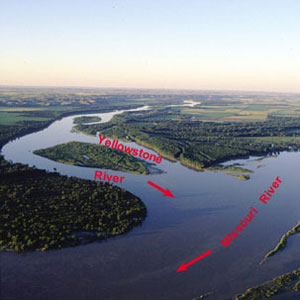

Missouri and Yellowstone rivers, MT-ND Clark’s group reaches the Missouri-Yellowstone confluence and finds the mosquitoes problematic. Southwest of Fort Peck, Lewis streamlines cooking procedures to allow more time to paddle. They make seventy miles down the Missouri.
July 17, 1806
Signs of danger
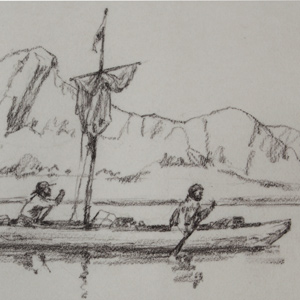

Between the Falls of the Missouri and the Marias River, Lewis sees signs of Indian hunters. On the Yellowstone, Clark passes an “Indian Fort”. Sgt. Ordway runs Pine Tree Rapids and Sgt. Gass waits above the falls.
May 30, 1805
The White Cliffs
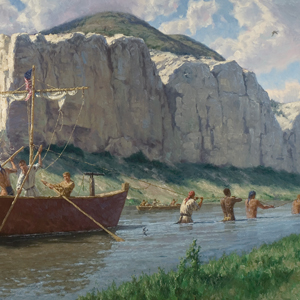

The men find that towing the boats among the white cliffs of the Upper Missouri River Breaks is harder than usual. Lewis tests the humidity, and Pvt. Whitehouse describes an empty Atsina camp.
June 23, 1806
Three Nez Perce guides
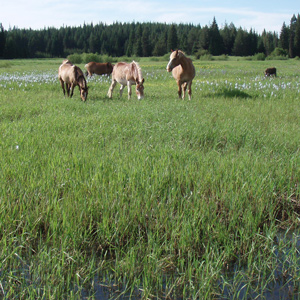

While waiting at Weippe Prairie for mountain snow to melt, the hunters imitate bleating fawns to call in the does. Three Nez Perce guides arrive, and all is made ready to cross the Bitterroot Mountains.
May 28, 1805
Judith River oasis
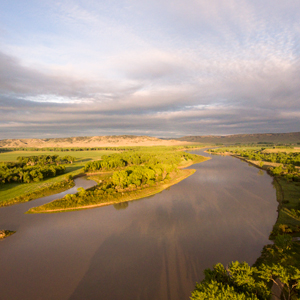

They tow the boats twenty miles reaching the fertile Judith River Basin. Lewis finds the change reviving. In St. Louis, military commander James Bruff proposes a mission for the expedition’s barge.
Notes
| ↑1 | “Lager der Gros Ventres des prairies am obern Missouri. Camp des Gros Ventres des prairies sur le Missouri. Camp of the Gros Ventres of the prairies on the upper Missouri.” New York Public Library Digital Collections. Accessed 22 December 2020. https://digitalcollections.nypl.org/items/510d47da-c45e-a3d9-e040-e00a18064a99. |
|---|---|
| ↑2 | For the dangers of this portion of the expedition, see The Marias River Risk. |
| ↑3 | Loretta Fowler and Regina Flannery, Handbook of North American Indians: Plains Vol. 15, Raymond J. DeMallie, Ed. (Washington, D.C.: Smithsonian Institute, 1978), 677–67. |
| ↑4 | Moulton, Journals, 8:90n9; William Bright, A Glossary of Native American Toponyms and Ethnonyms from the Lewis and Clark Journals, University of Colorado, accessed on 28 April 2020, https://lewisandclarkjournals.unl.edu/item/lc.sup.bright.01. |
| ↑5 | “Gros Ventre,” Wikipedia accessed on 24 November 2020, https://en.wikipedia.org/wiki/Gros_Ventre. |

